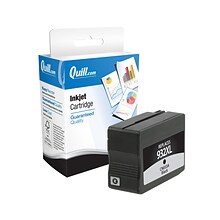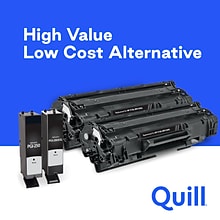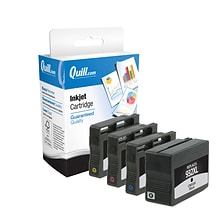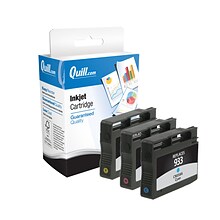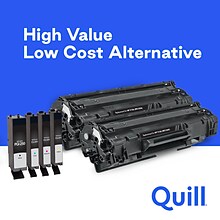HP Ink Jet Printers Cartridges for OfficeJet 7610 - H912a
Benefits of OfficeJet 7610 pigment-based ink
HP 932 and 933 OfficeJet 7610 ink cartridges contain pigment-based ink. That means these HP printer cartridges contain a powdery substance combined with water. When printing an image, the pigment sits on top of the paper and bonds with it instead of being absorbed like dye-based inks. This means the colors are more vibrant. This process also makes the final print water- and light-resistant so they last years when properly stored or displayed.
OfficeJet 7610 ink cartridge page yields
HP determines the page yield of ink cartridges through a series of tests. They repeatedly print pages with various amounts of images or text, using printer, photo, or copy paper, until quality diminishes. The final count of prints is the page yield. The HP 932 black and HP 933 color cartridges (cyan, magenta, and yellow) come in two sizes (standard and XL), which provide different yields:
- HP 932 black ink cartridge: 400 pages
- HP 933 cyan, magenta, and yellow cartridges: 330 pages each
- HP 932XL black ink cartridge: 1,000 pages
- HP 933XL ink cartridges in cyan, magenta, and yellow: 825 pages each
Color options are available in separate cartridges so users only have to buy one color at a time as they run out.
Understanding HP OfficeJet 7610 ink droplet size
The printer releases ink on the page in tiny droplets. The smaller the drops the sharper the final image result. This is especially important for photo printing. The droplet size is measured in picoliters( pl). The color cartridges for the HP OfficeJet 7610 have a drop size of 7pl for sharp, professional quality images. The 7610 printer has a dots per inch (dpi) of 1200. This means there is a matrix of up to 4800 x 1200 ink dots per inch of printed image.
Environmental and social benefits of HP printer ink
HP designs all its ink and toner with the environment in mind. Cartridges feature recycled materials and are packaged in such a way to reduce waste. HP also helps others by providing work for third world countries through bottle recycling. After processing, the bottle material forms the basis of ink cartridges.












